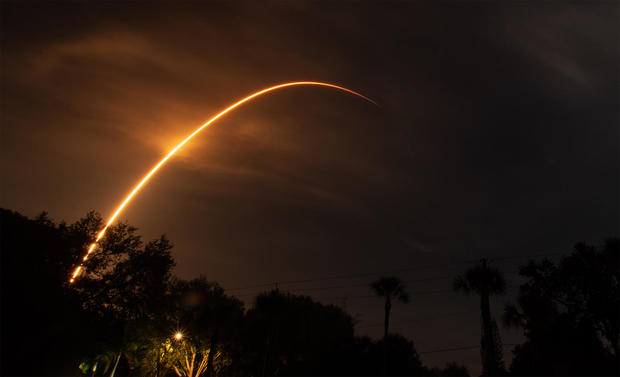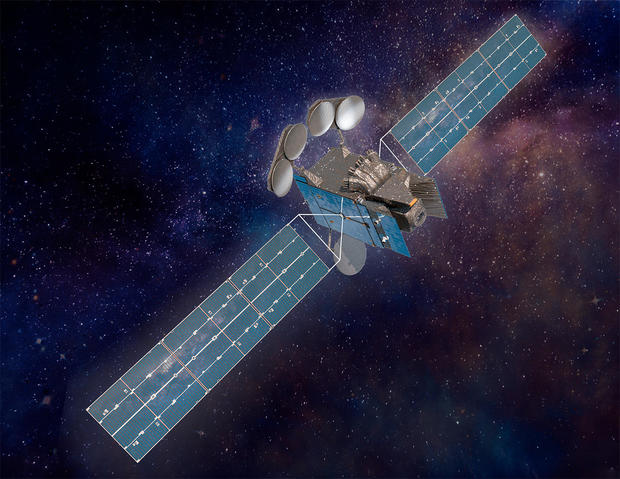Lighting up the overnight sky, a SpaceX Falcon 9 rocket streaked into orbit early Friday carrying an Intelsat communications satellite hosting a $210 million NASA-Smithsonian spectrometer designed to measure air quality and pollution across North America.
The Intelsat 40E satellite will provide broadband data to mobile users, from commercial aircraft to cruise ships, while at the same time serving as a platform for the Tropospheric Emissions: Monitoring of Pollution, or TEMPO, light analyzer.
Data collected by TEMPO will help researchers develop more accurate air quality forecasts and a deeper knowledge of atmospheric chemistry. It is the first such instrument designed to monitor air pollution over the Americas, on an hourly basis, from space.
"You've probably seen satellite imagery of hurricanes, and you can see it moving and swirling, you're visualizing the weather," TEMPO researcher Laura Judd said in an interview with CBS News. "Instead of seeing clouds, what we're going to see are these largely invisible pollutants, and we call that 'chemical weather.'
"You are going to see where they originate and how they're blowing, where they're going. You'll also see them go away, because they'll interact chemically and turn into some other species or they'll deposit onto the ground. But largely, what TEMPO's going to give us is the visualization of chemical weather."
SpaceX's 23rd launch this year got off to a thundering start at 12:30 a.m. EDT when the Falcon 9's nine first stage engines roared to life at the Cape Canaveral Space Force Station.
Climbing away to the east over the Atlantic Ocean, the rocket put on a spectacular show as it smoothly accelerated, shattering the overnight calm with a crackling roar as it consumed propellants, lost weight and accelerated atop 1.7 million pounds of thrust.
After boosting the rocket out of the lower atmosphere, the first stage peeled away and headed for landing on an offshore droneship while the second stage carried out two engine firings to reach the planned payload deploy orbit.
All of that went by the book, and the Intelsat 40E satellite was released to fly on its own 32 minutes after launch.
Built by Maxar, the 13,500-pound satellite will use on-board thrusters to reach its operational orbit 22,300 miles above the equator at 91 degrees west longitude where it will take 24 hours to complete one orbit and will thus stay perched in the sky above North America.
"Its primary commercial mission is connectivity for mobility services," said Jean-Luc Froeliger, Intelsat senior vice president of Space Systems. "What it means is providing internet services for commercial airline passengers, internet services for regional business jets as well as for cruise passengers. Mobility services from Intelsat 40E will also assist with disaster recovery."
Checkout and calibration will take until the end of May when commercial operations will begin and the TEMPO instrument, built by Ball Aerospace, will be turned on. Data from the instrument will be collected by Intelsat and relayed to Smithsonian Astrophysical Observatory researchers for analysis.
"One of the things that makes us unique is that we are developed as a hosted payload, which is a relatively new business model that NASA is using to enable placing instruments like TEMPO into an orbit at greatly reduced cost," said TEMPO project manager Kevin Daugherty of NASA's Langley Research Center
"So TEMPO will be riding on a geostationary communications satellite looking at the same region of Earth every day — greater North America — rather than getting a once-a-day look, often at the same time of day, in low-Earth orbit."
About the size of a home washing machine, TEMPO's ultraviolet-visible light spectrometer will capture sunlight reflected from the atmosphere, separating it into 2,000 component wavelengths.
That hyperspectral data will capture the chemical fingerprints of gases in the atmosphere and help researchers determine concentrations, movement and threats to public health.
Along with helping provide more accurate pollution advisories, TEMPO data will be used in concert with ground-based instruments to improve computer models of atmospheric chemistry.
"TEMPO will provide not only an independent dataset to validate (whether) models actually capture what happens in the morning and how it evolves into the afternoon, there are also scientists ... working on ingesting TEMPO data within their models as a constraint to make those models better.
"The goal is to create more accurate air quality forecasts, which in the end, we can (use to) better inform the public on air quality local to their area."
TEMPO is the second of three planned space-based pollution monitors. The first such instrument — the Geostationary Environment Monitoring Spectrometer, or GEMS — was launched with a Korean satellite in 2020 to cover eastern Asia.
The third instrument in the series, known as Sentinel 4, will launch with a European Meteosat relay station to monitor air quality across North Africa, Europe and western Asia.
https://news.google.com/rss/articles/CBMiUmh0dHBzOi8vd3d3LmNic25ld3MuY29tL25ld3Mvc3BhY2V4LWxhdW5jaGVzLW5hc2EtYWlyLXBvbGx1dGlvbi1tb25pdG9yLXNhdGVsbGl0ZS_SAVZodHRwczovL3d3dy5jYnNuZXdzLmNvbS9hbXAvbmV3cy9zcGFjZXgtbGF1bmNoZXMtbmFzYS1haXItcG9sbHV0aW9uLW1vbml0b3Itc2F0ZWxsaXRlLw?oc=5
2023-04-07 11:58:00Z
1902046819




Tidak ada komentar:
Posting Komentar